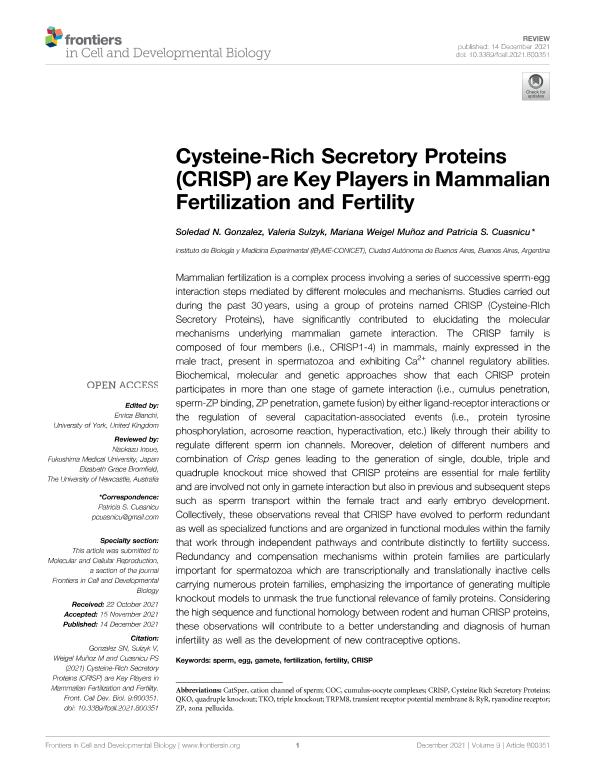Mostrar el registro sencillo del ítem
dc.contributor.author
Gonzalez, Soledad Natalia

dc.contributor.author
Sulzyk, Valeria

dc.contributor.author
Weigel Muñoz, Mariana

dc.contributor.author
Cuasnicu, Patricia Sara

dc.date.available
2022-05-26T03:24:22Z
dc.date.issued
2021
dc.identifier.citation
Gonzalez, Soledad Natalia; Sulzyk, Valeria; Weigel Muñoz, Mariana; Cuasnicu, Patricia Sara; Cysteine-rich secretory proteins (CRISP) proteins are key players for mammalian fertilization and fertility; Frontiers Media; Frontiers in cell and developmental biology; 2021; 1-13
dc.identifier.issn
2296-634X
dc.identifier.uri
http://hdl.handle.net/11336/158220
dc.description.abstract
Mammalian fertilization is a complex process involving a series of successive sperm-egg interaction steps mediated by different molecules and mechanisms. Studies carried out during the past 30 years, using a group of proteins named CRISP (Cysteine-RIch Secretory Proteins), have significantly contributed to elucidating the molecular mechanisms underlying mammalian gamete interaction. The CRISP family is composed of four members (i.e. CRISP1-4) in mammals, mainly expressed in the male tract, present in spermatozoa and exhibiting Ca2+ channel regulatory abilities. Biochemical, molecular and genetic approaches show that each CRISP protein participates in more than one stage of gamete interaction (i.e. cumulus penetration, ZP-binding, ZP penetration, gamete fusion) by either ligand-receptor interactions or the regulation of several capacitation-associated events (i.e. protein tyrosine phosphorylation, acrosome reaction, hyperactivation, etc) likely through their ability to regulate different sperm ion channels. Moreover, deletion of different numbers and combination of Crisp genes leading to the generation of single, double, triple and quadruple knockout mice showed that CRISP proteins are essential for male fertility and are involved not only in gamete interaction but also in previous and subsequent steps such as sperm transport within the female tract and early embryo development. Collectively, these observations reveal that CRISP have evolved to perform redundant as well as specialized functions and are organized in functional modules within the family that work through independent pathways and contribute distinctly to fertility success. Redundancy and compensation mechanisms within protein families are particularly important for spermatozoa which are transcriptionally and translationally inactive cells carrying numerous protein families, emphasizing the importance of generating multiple knockout models to unmask the true functional relevance of family proteins. Considering the high sequence and functional homology between rodent and human CRISP proteins, these observations will contribute to a better understanding and diagnosis of human infertility as well as the development of new contraceptive options.
dc.format
application/pdf
dc.language.iso
eng
dc.publisher
Frontiers Media

dc.rights
info:eu-repo/semantics/openAccess
dc.rights.uri
https://creativecommons.org/licenses/by-nc-sa/2.5/ar/
dc.subject
SPERM
dc.subject
EGG
dc.subject
FERTILIZATION
dc.subject
FERTILITY
dc.subject
CRISP
dc.subject
GAMETE
dc.subject.classification
Bioquímica y Biología Molecular

dc.subject.classification
Medicina Básica

dc.subject.classification
CIENCIAS MÉDICAS Y DE LA SALUD

dc.subject.classification
Biología Reproductiva

dc.subject.classification
Ciencias Biológicas

dc.subject.classification
CIENCIAS NATURALES Y EXACTAS

dc.title
Cysteine-rich secretory proteins (CRISP) proteins are key players for mammalian fertilization and fertility
dc.type
info:eu-repo/semantics/article
dc.type
info:ar-repo/semantics/artículo
dc.type
info:eu-repo/semantics/publishedVersion
dc.date.updated
2022-05-06T16:06:11Z
dc.identifier.eissn
2296-634X
dc.journal.pagination
1-13
dc.journal.pais
Suiza

dc.journal.ciudad
Lausanne
dc.description.fil
Fil: Gonzalez, Soledad Natalia. Consejo Nacional de Investigaciones Científicas y Técnicas. Instituto de Biología y Medicina Experimental. Fundación de Instituto de Biología y Medicina Experimental. Instituto de Biología y Medicina Experimental; Argentina
dc.description.fil
Fil: Sulzyk, Valeria. Consejo Nacional de Investigaciones Científicas y Técnicas. Instituto de Biología y Medicina Experimental. Fundación de Instituto de Biología y Medicina Experimental. Instituto de Biología y Medicina Experimental; Argentina
dc.description.fil
Fil: Weigel Muñoz, Mariana. Consejo Nacional de Investigaciones Científicas y Técnicas. Instituto de Biología y Medicina Experimental. Fundación de Instituto de Biología y Medicina Experimental. Instituto de Biología y Medicina Experimental; Argentina
dc.description.fil
Fil: Cuasnicu, Patricia Sara. Consejo Nacional de Investigaciones Científicas y Técnicas. Instituto de Biología y Medicina Experimental. Fundación de Instituto de Biología y Medicina Experimental. Instituto de Biología y Medicina Experimental; Argentina
dc.journal.title
Frontiers in cell and developmental biology
dc.relation.alternativeid
info:eu-repo/semantics/altIdentifier/url/https://www.frontiersin.org/articles/10.3389/fcell.2021.800351/full
dc.relation.alternativeid
info:eu-repo/semantics/altIdentifier/doi/http://dx.doi.org/10.3389/fcell.2021.800351
Archivos asociados
